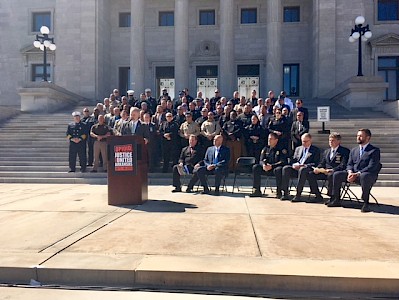Brief of Amici Curiae the Arkansas Opioid Recovery Partnership, the Association of Arkansas Counties,
and the Arkansas Municipal League
Click here to read the Amici Brief in William K. Harrington, United States Trustee, Region 2 v. Purdue Pharma L.P., et al
An Update on the Arkansas Opioid Recovery Partnership (ARORP)
By Kirk R. Lane, Director, Arkansas Opioid Recovery Partnership
Wednesday, Oct. 19, 2022
The Arkansas Opioid Recovery Partnership (ARORP) wants to provide you with some updates as we prepare to launch our website (www.arorp.org) and services on Nov. 4, 2022. We have been diligently working to bring together an Advisory Board and infrastructure needs to ready ARORP to provide funding and services across Arkansas. We have met with national level research groups and studied what is happening in other states with opioid settlement funding, and we believe that Arkansas is the fastest progressing state on the management of these funds to date. Arkansas cities and counties were recently the first nationally to receive their second settlement funding check from opioid distributors. This success is due in large part to the commitment of city and county leaders as well as the work of the Arkansas Opioid Litigation Team throughout this effort.
On Nov. 4, we will meet with the ARORP Advisory Board members for the first time and provide them with orientation to ARORP and the mission, principles, and guidelines of the partnership. Upon completion of this meeting, we are planning a press conference to announce the launch of the ARORP website to Arkansans. This website will outline our mission and purpose and make introductions of the board and the ARORP leadership team. The website will have proposal templates for interested parties and programs to apply for funding from this program. There will be a general proposal template and several directed proposal templates for Naloxone and Overdose Response Team funding. The proposal was designed to be straightforward and simple and should not require a grant writer to submit. There are detailed essential questions about the design, purpose, budget, and sustainability of any proposal.
ARORP will require the person or entity making any funding proposal to submit a letter of support from the county judge(s) and mayor(s) in the areas they will primarily serve. This requires the applicant to have conversations with city and county leaders explaining their purpose and mission and to obtain the support of city and county leaders to be served. We hope this requirement will allow you to vet proposals because you know best what is needed in your communities, and you are likely to know the applicants submitting these proposals. This also serves to provide insight into resources that will be available if approved in your jurisdictions. Those entities will then submit proposals with the support of relevant county judges and mayors to ARORP for review and recommendation by ARORP staff and the ARORP Advisory Board.
We will research proposals to ensure that any proposal approved for funding meets the requirements contained in court settlements and court orders, the Arkansas Opioids MOU, and the ARORP principles and guidelines — and that proposals don’t duplicate what the state is already providing. Approved proposals will be formulated into agreements to ensure that conditions are met, data is provided, and that acceptable standards of operations are in place. Once a proposal is approved with an agreement in place, the proposal will be submitted to the Qualified Settlement Fund (QSF) to be reviewed for compliance with court settlements and court orders, and the Arkansas Opioids MOU. After funding by the QSF and implementation of the proposal, you will receive notice from ARORP that the proposal was successful in your area. We hope and encourage you to reach out to these approved projects for updates, to get firsthand updates from them on their progress. ARORP will periodically do inspections of funded proposals to ensure they are operating within their agreements. The website will serve as transparency to the funded proposals and data that is derived from these programs. It is important that these funded services reach the front doors of your community, so please consider communicating these achievements to your citizens and communities, as you know best.
We are excited to work with all Arkansas mayors and county judges, as you have made this possible, and we look forward to making progress to abate the effects of the opioid epidemic in your communities. ARORP has brought on board Tenesha Barnes who has been the Director of Prevention Services for DAABHS for the last seven years. She has a wealth of experience in dealing with programs, funding operations, and evaluation. She brings a community-wide resource dynamic to the team. She has assumed the role of Assistant Director of ARORP to better serve our cities and counties. As we move forward, please know that Tenesha and I are available to each of you, to discuss any thoughts or concerns that you may have. We have purposely designed this process to be transparent and simple, for your benefit as well as the benefit of your communities. We will provide updates from time to time as new programs are being developed. Thanks again for being that leader that will change the course of the opioid epidemic in Arkansas.
MATERIALS AND ANNOUNCEMENTS
Plaintiffs' Omnibus Response to Defendants' Motions filed on Aug. 30, 2018.
Second Amended Complaint filed on April 2, 2018 in Crittenden County Circuit Court.
News Release announcing March 21, 2018 press conference.
News Release announcing April 6, 2018 Arkansas Supreme Court decision.
Watch video from the news conference announcing the lawsuit.
Opioid news conference photos.
Media Coverage of Arkansas Opioid Litigation
State partnership overseeing opioid settlement funds announces plans, application process — Arkansas Democrat-Gazette
DEA: Annual drug take-back effort collects nearly 420 tons in US, more than 14 tons in Arkansas – May, 2021
State aims to tackle addiction in the courtroom – Arkansas Money & Politics
One state's novel idea to make Big Pharma pay for opioid epidemic — CNN
Attorney: Governments seeking to recover 'probably...billions' from opioid companies – Talk Business & Politics
Opioid Crisis: Is Arkansas Paving the way for big pharma, not taxpayers, to pay for addiction? — Newsweek Online
Arkansas cities, counties sue drug makers over opioid crisis — Associated Press
Other Media Coverage
Opioid-makers gushed dollars to Arkansas doctors — Arkansas Democrat-Gazette
Bitter Pill — Arkansas Times
Opioid crisis affects all Americans, rural and urban — U.S. Department of Agriculture
The opioid epidemic: A crisis years in the making — The New York Times
Opioid Resources
 A Prescription for Action: Local Leadership in Ending the Opioid Crisis
A Prescription for Action: Local Leadership in Ending the Opioid Crisis
This joint report from National Association of Counties (NACo) and the National League of Cities (NLC) examines how cities and counties can strengthen collaboration with each other and state, federal, private-sector and non-profit partners to tackle the opioid crisis. Several of the recommendations are accompanied by existing local practices from cities and counties. The report also includes recommendations for state and federal officials, who are pivotal partners in local efforts to combat opioid misuse, diversion, overdose and death.
Centers for Disease Control and Prevention
National Association of Counties
U.S. Department of Health and Human Services



